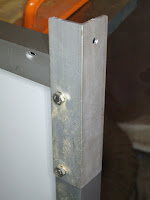When a tree becomes inconvenient, it must go! Case in point is a pine tree near my house that had been partly shading my solar collectors for the hot water for my home in the afternoon. I was willing to tolerate that, but eventually it grew high enough to block my Dish satellite so that I was losing HD signals. Two strikes and it was out!
 |
| Offending Pine tree on the left |
You can see the offending tree on the left. It is concealing the satellite dish to the left of the dormer window on the left side of the house, and the solar collectors are below the second floor windows towards the right.
 |
| Trunks down and partly bucked |
So I called my neighbor John who is always happy to help me cut down a tree and he came over with his pickup, chainsaw, length of chain and steel rope to tension the tree and we got to work. It took some careful strategy to tie a cable from the tree to John's pickup so we could haul it in the right direction as it came down. There were two large main branches, one went to the left, and the other to the right and down slope. They both landed pretty much where we wanted them.
We hauled off all the branches to my burn pile and lit that off while we were cutting up the trunk.
 |
| Burn pile before |
Pine needles burn very quickly so the fire did not need a lot of tending and maintenance, although it was somewhat smoky. There's nothing like the smell of wood smoke in the fall.
 |
| Burn pile almost done. |
We cut the trunk into firewood lengths and I have stacked it in the backyard to season for a few years before I split it. Pine wood has so much pitch that it takes a long time to dry out. It's not a good idea to burn unseasoned pine in the wood stove because it creates a lot of creosote buildup in the chimney. That creosote can create a chimney fire and burn down your house. I get my chimneys cleaned every year or two just to be safe.
 |
| Tree stump and stacked firewood |
Now the tree is down, my satellite dish has a clear line of sight to the HD satellite, and I'm getting better performance from my solar collectors. I guess you could say I am back in hot water!
A clear line of sight for my solar and satellite
While I have contributed a substantial amount of carbon to the atmosphere by burning the tree, I see it as just shortening the carbon cycle. The tree would eventually have died and rotted, releasing carbon back into the atmosphere. I am sure the equation does not pencil out optimally, but by gaining more free solar energy, it probably nets out.



















